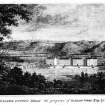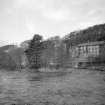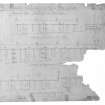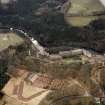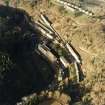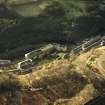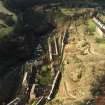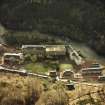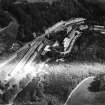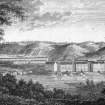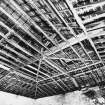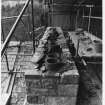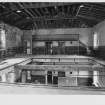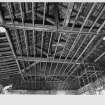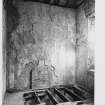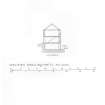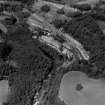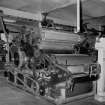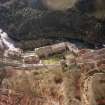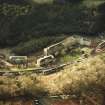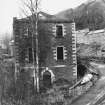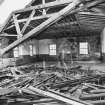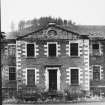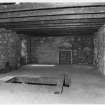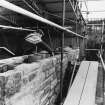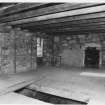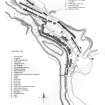New Lanark
Mill (18th Century), Village (18th Century)
Site Name New Lanark
Classification Mill (18th Century), Village (18th Century)
Alternative Name(s) Falls Of Clyde; River Clyde; Clyde Water; New Lanark Mills; New Lanark Industrial Village
Canmore ID 46623
Site Number NS84SE 58
NGR NS 88025 42614
NGR Description Centred NS 88025 42614
Datum OSGB36 - NGR
Permalink http://canmore.org.uk/site/46623
First 100 images shown. See the Collections panel (below) for a link to all digital images.
- Council South Lanarkshire
- Parish Lanark
- Former Region Strathclyde
- Former District Clydesdale
- Former County Lanarkshire
NS84SE 58.00 centred 88025 42614
NS84SE 58.01 NS 87950 42556 Mill Number One
NS84SE 58.02 NS 87982 42532 Mill Number Two
NS84SE 58.03 NS 88009 42516 Mill Number Three (with Turbine House) [See also NS84SE 58.34]
NS84SE 58.04 NS 88068 42475 Mill Number Four
NS84SE 58.05 NS 88104 42432 The School
NS84SE 58.06 NS 88077 42504 The Institute
NS84SE 58.07 NS 88025 42594 3 Rosedale Street, Robert Owen's House
NS84SE 58.08 NS 87992 42611 5-7 Rosedale Street, David Dale's House [See also NS84SE 58.35 and NS84SE 58.36 ]
NS84SE 58.09 NS 88014 42650 New Lanark Church
NS84SE 58.10 NS 88069 42556 Mill Offices [New Lanark Conservation Trust]
NS84SE 58.11 NS 88432 42803 1 New Lanark Road, South Entrance Lodge
NS84SE 58.12 NS 88093 42562 New Lanark Road, New Buildings
NS84SE 58.13 NS 87887 42713 1 Braxfield Row
NS84SE 58.14 NS 88130 42492 1-2 and 5 Caithness Row
NS84SE 58.15 NS 88158 42445 9-10 and 13 Caithness Row
NS84SE 58.16 NS 87962 42626 Rosedale Street, 1-2 Double Row
NS84SE 58.17 NS 87911 42650 Rosedale Street, 9-10 Double Row
NS84SE 58.18 NS 87903 42656 Rosedale Street, 11-12 Double Row (Tenement Stair; Tenement Stair Museum)
NS84SE 58.19 NS 87935 42661 Rosedale Street, 1 Long Row
NS84SE 58.20 NS 87965 42656 1-3 Mantilla Row
NS84SE 58.21 NS 88104 42552 New Lanark Road, Nursery Buildings
NS84SE 58.22 NS 88096 42347 Dyeworks [Visitor Centre]
NS84SE 58.23 NS 88115 42353 Engineer's shop
NS84SE 58.24 NS 88090 42287 Retort House [See also NS84SE 58.84]
NS84SE 58.25 NS 88043 42585 Telephone Call Box [K6 type]
NS84SE 58.26 NS 879 426 Water Row
NS84SE 58.27 NS 87914 42662 Rosedale Street, General
NS84SE 58.28 NS 88 42 Ponclair Burn, Inlet for Water
NS84SE 58.29 NS 88088 42888 Gasworks [See also NS84SE 58.24 and NS58SE 58.84]
NS84SE 58.30 NS 88128 42523 229-231 New Lanark Road, Lanark Co-op Provident
NS84SE 58.31 NS 88137 42511 New Lanark Road, Post Office
NS84SE 58.32 NS 87938 42530 Water Houses
NS84SE 58.33 NS 88116 42077 Weir [River Clyde]
NS84SE 58.34 NS 88064 42516 Mill Number Three, Steam Engine House [See also NS84SE 58.03]
NS84SE 58.35 NS 88002 42606 5-7 Rosedale Street, David Dale's House, East Wing [See also NS84SE 58.08]
NS84SE 58.36 NS 87986 42614 5-7 Rosedale Street, David Dale's House, West Wing [See also NS84SE 58.08]
NS84SE 58.37 NS 87878 42720 New Lanark Road, 2 Braxfield Row
NS84SE 58.38 NS 87874 42725 New Lanark Road, 3 Braxfield Row
NS84SE 58.39 NS 87866 42732 New Lanark Road, 4 Braxfield Row
NS84SE 58.40 NS 87859 42734 New Lanark Road, 5 Braxfield Row
NS84SE 58.41 NS 87850 42745 New Lanark Road, 6 Braxfield Row
NS84SE 58.42 NS 87842 42752 New Lanark Road, 7 Braxfield Row
NS84SE 58.43 NS 87833 42759 New Lanark Road, 8 Braxfield Row
NS84SE 58.44 NS 87825 42765 New Lanark Road, 9 Braxfield Row
NS84SE 58.45 NS 87810 42774 New Lanark Road, 10 Braxfield Row
NS84SE 58.46 NS 88141 42483 3 and 6-7 Caithness Row
NS84SE 58.47 NS 88148 42469 8 Caithness Row
NS84SE 58.48 NS 88127 42502 4 Caithness Row
NS84SE 58.49 NS 88123 42507 Caithness Row, Counting House
NS84SE 58.50 NS 88164 42434 11 and 14-15 Caithness Row
NS84SE 58.51 NS 88157 42448 12 Caithness Row
NS84SE 58.52 NS 88170 42423 16 Caithness Row
NS84SE 58.53 NS 87952 42631 Rosedale Street, 3-4 Double Row [Youth Hostel]
NS84SE 58.54 NS 87940 42636 Rosedale Street, 5-6 Double Row [Youth Hostel]
NS84SE 58.55 NS 87929 42641 Rosedale Street, 7-8 Double Row [Youth Hostel]
NS84SE 58.56 NS 87893 42661 Rosedale Street, 13-14 Double Row
NS84SE 58.57 NS 87882 42666 Rosedale Street, 15-16 Double Row
NS84SE 58.58 NS 87872 42671 Rosedale Street, 17-18 Double Row
NS84SE 58.59 NS 87862 42675 Rosedale Street, 19-20 Double Row
NS84SE 58.60 NS 87851 42681 Rosedale Street, 21-22 Double Row
NS84SE 58.61 NS 87841 42685 Rosedale Street, 23-24 Double Row
NS84SE 58.62 NS 87820 42718 Rosedale Street, 14 Long Row
NS84SE 58.63 NS 87927 42667 Rosedale Street, 2 Long Row
NS84SE 58.64 NS 87921 42671 Rosedale Street, 3 Long Row
NS84SE 58.65 NS 87913 42675 Rosedale Street, 4 Long Row
NS84SE 58.66 NS 87901 42681 Rosedale Street, 5 Long Row
NS84SE 58.67 NS 87892 42685 Rosedale Street, 6 Long Row
NS84SE 58.68 NS 87884 42689 Rosedale Street, 7 Long Row
NS84SE 58.69 NS 87869 42694 Rosedale Street, 8 Long Row
NS84SE 58.70 NS 87863 42699 Rosedale Street, 9 Long Row
NS84SE 58.71 NS 87854 42704 Rosedale Street, 10 Long Row
NS84SE 58.72 NS 87846 42708 Rosedale Street, 11 Long Row
NS84SE 58.73 NS 87837 42712 Rosedale Street, 12 Long Row
NS84SE 58.74 NS 87827 42717 Rosedale Street, 13 Long Row
NS84SE 58.75 NS 88086 42569 New Lanark Road, New Buildings
NS84SE 58.76 NS 88079 42575 New Lanark Road, New Buildings
NS84SE 58.77 NS 88072 42582 New Lanark Road, New Buildings
NS84SE 58.78 NS 88062 42591 New Lanark Road, New Buildings
NS84SE 58.79 NS 88053 42600 New Lanark Road, New Buildings
NS84SE 58.80 NS 88047 42603 New Lanark Road, New Buildings
NS84SE 58.81 NS 88105 42545 New Lanark Road, Nursery Buildings
NS84SE 58.82 NS 88117 42538 New Lanark Road, Nursery Buildings
NS84SE 58.83 NS 88422 42815 2 New Lanark Road, North Entrance Lodge
NS84SE 58.84 NS 88090 42282 Retort House, Chimney [See also NS84SE 58.24]
See also:
NS84SE 109 NS 8800 4262 New Lanark, Ice House
NS84SE 110 NS 8802 4265 169, 189-203 New Lanark Road
NS84SE 111 NS 87581 43154 New Lanark Road, Braxfield House
NS84SE 124 NS 88121 42324 Lade Overflow
NS84SE 125 NS 88108 42469 Lade
NS84SE 241 NS 88064 42276 Dundaff Linn
(Location cited as NS 880 426). New Lanark, founded 1784 by David Dale and Richard Arkwright. Important group of houses, mills and community buildings. No. 1 mill (1787) cut down to three storeys from five is rubble-built with a projecting staircase block with paired Palladain windows. No. 2 is five storeys high, extended in brick c. 1905, and No. 3 is five storeys high, externally as built c. 1826. The houses are mainly 3- and 4-storey, all with a 'sunk floor' owing to the steeply-sloping site. There are two community buildings: the Institute for the Formation of Character (1816) and the School (1817), both 2-storey and basement and both with central pediments. Other buildings of interest are the 3-storey store, the 4-storey Nursery Buildings, and the 3-storey mechanics' shop. Perhaps the most striking is, however, the 4-storey New Buildings (c. 1799) with its bellcote. Some of the housing, Nursery Buildings, and the store have been renovated and plans are in hand for more renovation.
J R Hume 1976.
NS84SE 58.00 88025 42614
Restoration/Conversion Architects:
Ian G Lindsay and Partners
Guide to the Ian G Lindsay Collection.
IGL W610/1-12 BRAXFIELD ROW
IGL W610/13-15 NEW BUILDINGS
IGL W610/16-17 NURSERY BUILDINGS
IGL W610/18 THE INSTITUTE
IGL W610/19-20 CAITHNESS ROW
IGL W610/21 LONG ROW
IGL W610/22 NEW LANARK GENERAL
See also:
IGL W804/1 NEW LANARK GENERAL
IGL W807/1 CAITHNESS ROW
IGL W811/1 DOUBLE ROW
IGL W895/1-7 BRAXFIELD ROW
(Undated) information in NMRS.
Publication Account (1985)
The village of New Lanark has justifiably been described as 'the outstanding industrial monument in Scotland', for it not only contains an unrivalled collection oflate 18th century and early 19th century mills, workers' houses and public buildings, but was also the scene of Robert Owen's famous attempt to humanise the industrial revolution. The mills remained in use until 1968, after which they rapidly became derelict but were saved from demolition by the New Lanark Conservation and Civic Trust The Trust co-ordinated the efforts of several interested groups and the majority of the work of restoration has been carried out by local unemployed youngsters. One of the first projects they tackled was the renovation of the Nursery Buildings, which subsequently won a Scottish Civic Trust award. Over the last ten years the village has been slowly brought back to life and now has a growing residential population supported by a number of small industries.
The original mills were established on the banks of the Clyde in 1784 to harness the power of the river and were founded by David Dale (a Glasgow banker) and his partner Richard Arkwright (the pioneer of mechanical spinning). By 1798, when Robert Owen was appointed manager, the village was already a thriving concern forming the largest collection of cotton mills in Scotland. During the next twenty years Owen expanded the work of the mills and introduced a series of radical social reforms, which greatly improved working conditions and turned New Lanark into a showplace drawing 20,000 visitors between 1815 and 1825.
Owen's concern for the well being, and therefore efficiency, of the workforce is reflected in the buildings erected during his period of management. In 1809 the Nursery was built to house 300 pauper apprentices who until then had been expected to sleep in the mill beside their machines. Four years later, in 1813, the Store was opened to improve the standard of goods available to the workers; it was run on co-operative lines and ensured that profiteering did not occur. One of Owen's principal interests was education, and two buildings commemorate this. The institute for the Formation of Character (1816) served as library, reading room, canteen, dancehall and place of worship; it was open to all the staff and their families, filling the function of a modem community centre. Equally important was the School, founded in 1817, which was Scotland's first school for infants. Other buildings of note are the Counting House and the New Buildings.
Information from ‘Exploring Scotland’s Heritage: The Clyde Estuary and Central Region’, (1985).
Publication Account (1986)
The importance of New Lanark as a pioneering enterprise of industrial and social organisation is well known. Founded in 1785 by David Dale in association with Richard Arkwright, and profoundly influenced by the social and educational ideals of Dale's son-in-law Robert Owen, by 1825 it had become a model industrial village complete with mills, church, school, community buildings, including shop and bake-house and workers' dwellings. The site occupies a narrow stretch of ground beside the River Clyde, just below Corra Linn Falls, and the close inter-relationship between the mills, community buildings and lade system is best appreciated from the illustrations and site plans. Although the mills themselves have been subjected to alteration and reconstruction, the whole complex apart from No. 4 mill, which was burnt down in 1883, remains much as Dale and Owen planned it. A current programme of restoration by the New Lanark Conservation Trust in association with the Scottish Development Department, has been accompanied by a series of measured surveys undertaken by the Commission, which have included Owen's New Institution, erected between 1813 and 1816, and his School c.1819. The two principal floors of the institute, each 140 ft (42.67m) long by 19 ft (5.79m) wide, were designed for educational and recreational purposes, the 21 ft-high (6.40m) upper floor being formerly divided into two apartments with side-galleries; the 150ft by 42ft (45.72m by 12.80m) first and second floors of the school were each divided into two large rooms and furnished at their inner ends with a musicians' gallery enclosed by delicate iron balustrades.
The terraced rows of workers' tenements provide a remarkable insight into the living standards of the times. Apart from Braxfield Row, which is stepped along the descent of the approach road, the remainder of those here illustrated are built into the sloping hillside, and consequently the rear of the terraces usually incorporate one or more floors below street level with independent access. Flatted throughout and approached by communal stairs, the buildings fall into two main categories, the central blocks of New Buildings and Double Row/Water Row being of double-room depth, often allowing a four-square arrangement on each floor, and the remainder of single room depth. Each dwelling incorporated from one to four rooms, the principal elements being the fireplace, scullery and box-beds, the last especially affording a flexible unit for several permutations of house-layout. Flagged floors and a more limited window area made the basements less suited for habitation, and they appear to have been soon relegated to the function of wash-houses and possibly latrines, although the existence of no fewer than eight box-beds in two rooms in the basement of Water Row point to their possible use as pauper dormitories. The original domestic fittings were of a fairly standard character: the fireplaces had plain stone surrounds and latterly an iron range equipped with swey and smoke-board; another universal feature was the hurley-bed (Scots), or truckle-bed-a wooden drawer or box mounted on wheels capable of accommodating two persons, and low enough to be slipped under the fixed bed when not in use.
Information from ‘Monuments of Industry: An Illustrated Historical Record’, (1986).
Project (2007)
This project was undertaken to input site information listed in 'Civil engineering heritage: Scotland - Lowlands and Borders' by R Paxton and J Shipway, 2007.
Publication Account (2007)
The village of New Lanark was founded in 1785 by David Dale, a Glasgow merchant, and Richard Arkwright, the
cotton spinning pioneer. It is located in a heavily wooded gorge south of the market town of Lanark, the site being chosen for the availability of water power from the Clyde to drive the machinery of the newly developed spinning mills. Dale and his engineer William Kelly are understood to have directed the substantial work in harnessing of the water power and its transmission to the mill machinery and by 1786 Mill No. 1 (of four) was operational. Dale’s son-in-law, Robert Owen the social reformer, became manager of the mills in 1800. He dismissed Kelly and appointed Robert Humphreys as works manager. Owen introduced conditions and educational opportunities for his workers that were a hundred years ahead of their time and the venture prospered, becoming one of the world’s largest cotton mill centres supporting 2500 people.
The water power was derived from a dam built on the side of the river, later crossing it, from where the water
was led through a tunnel approximately 250 yards long and about 12 ft diameter under the rocky hillside into the lade about 22 ft wide and 6 ft deep which runs through the heart of the village. The lade provided water to
intake sluices at each mill into which it was led to turn basement high breast-shot wheels of up to about 26 ft
diameter to power machinery. In 1852 ten wheels were producing a total of about 450 hp. Later these wheels
were gradually replaced by water turbines and electric motors, with steam engines being used as a supplementary source of power when required.
A fascinating example of cast-iron technology can be seen in the bridge crossing the lade at the back of the
Institute, which was built in ca.1816. The cast-iron beams may date from about the same period, and probably originate from Mill No. 3, which was rebuilt to a fireproof design after burning down in 1819. This has similar beams in its cast-iron frame, a section of which has been preserved. In elevation the beams are hogged, being about 23 in. deep at the centre and 15 in. at each end and, characteristically for beams of this date, they do not have top flanges.
Mill No. 3 also has an unusual fire resistant roof structure; it is floored with cast-iron plates at attic level, while
the roof at the eastern end consists of slates wired on to an iron frame. The Institute is also of historical engineering interest for its original heating system in which hot air was passed through the cast-iron support columns to warm the upper rooms.
The village and mills survived as a manufacturing concern until 1968 when they finally closed. In recent decades the buildings have been restored and have developed a new life as a World Heritage Site with outstanding interpretive and visitor facilities.
R Paxton and J Shipway 2007
Reproduced from 'Civil Engineering heritage: Scotland - Lowlands and Borders' with kind permission from Thomas Telford Publishers.
Standing Building Recording (May 2017 - June 2019)
NS 88025 42614 A built environment study was undertaken to provide a comprehensive understanding of the development of, and changes to, the World Heritage Site of New Lanark (Canmore ID: 46623) since its establishment in 1784. The work, carried out between May 2017 and June 2019, included archival and historical research, 3D laser scanning and the production of architectural phase drawings of all the buildings. The results were presented in a gazetteer for use in the future management of the site.
Archive: New Lanark World Heritage Trust
Funder: New Lanark World Heritage Trust
Kenny Macfadyen and Laure Emery - Addyman Archaeology
(Source: DES Vol 20)











































































































